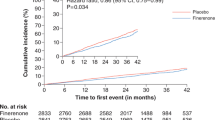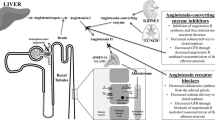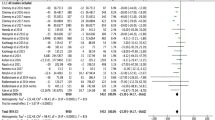Key Points
-
Chronic kidney disease (CKD) is accompanied by a very substantial increase in cardiovascular risk
-
Inhibitors of the renin–angiotensin–aldosterone system (RAAS) are frequently underprescribed because of the risk of hyperkalaemia
-
Use of statins at high doses might reduce cardiovascular risk in patients with CKD
-
New potassium binders can enhance RAAS blockade without increasing the risk of hyperkalaemia
-
New nonsteroidal mineralocorticoid-receptor antagonists that reduce the risk of hyperkalaemia are being tested in trials
-
Patients with heart failure treated with LCZ696 show a clear improvement in cardiovascular outcomes accompanied by improved renal function and reduced hyperkalaemia
Abstract
The development and progression of cardiovascular disease (CVD) and renal disorders are very closely related. In patients with chronic kidney disease (CKD), therapies proven to protect the cardiovascular and renal systems simultaneously are generally used only at low doses or not at all. In particular, patients with CKD who receive angiotensin-converting-enzyme inhibitors, angiotensin-receptor blockers, or mineralocorticoid-receptor antagonists (MRAs) often do not experience complete blockade of the renin–angiotensin–aldosterone system, primarily owing to the risk of hyperkalaemia. In this Review, we provide an overview of the available treatments required for adequate cardiorenal protection in patients with CKD. Drugs such as β-blockers that interfere with renin secretion will be discussed, in addition to agents that can prevent hyperkalaemia, such as potassium binders and nonsteroidal MRAs. Furthermore, the current literature on the role of statins, in addition to new compounds and dosing recommendations for the treatment of patients with CKD will also be reviewed. Further studies with these new compounds and doses are needed to ascertain whether these approaches can improve the long-term cardiovascular and renal prognosis in patients with CKD.
This is a preview of subscription content, access via your institution
Access options
Subscribe to this journal
Receive 12 print issues and online access
$209.00 per year
only $17.42 per issue
Buy this article
- Purchase on Springer Link
- Instant access to full article PDF
Prices may be subject to local taxes which are calculated during checkout



Similar content being viewed by others
References
Gansevoort, R. T. et al. Chronic kidney disease and cardiovascular risk: epidemiology, mechanisms, and prevention. Lancet 382, 339–352 (2013).
Levey, A. S. et al. The definition, classification, and prognosis of chronic kidney disease: a KDIGO Controversies Conference report. Kidney Int. 80, 17–28 (2011).
Ruiz-Hurtado, G. & Ruilope, L. M. Does cardiovascular protection translate into renal protection? Nat. Rev. Cardiol. 11, 742–746 (2014).
James, P. A. et al. 2014 evidence-based guideline for the management of high blood pressure in adults: report from the panel members appointed to the Eighth Joint National Committee (JNC 8). JAMA 311, 507–520 (2014).
Mancia, G. et al. 2013 ESH/ESC guidelines for the management of arterial hypertension: the Task Force for the Management of Arterial Hypertension of the European Society of Hypertension (ESH) and of the European Society of Cardiology (ESC). Eur. Heart J. 34, 2159–2219 (2013).
Group, S. R. A randomized trial of intensive versus standard blood-pressure control. N. Engl. J. Med. 373, 2103–2116 (2015).
Ruilope, L. M. Chronic kidney disease: blood pressure control in CKD — still a matter of debate. Nat. Rev. Nephrol. 9, 572–573 (2013).
Williams, B. et al. Spironolactone versus placebo, bisoprolol, and doxazosin to determine the optimal treatment for drug-resistant hypertension (PATHWAY-2): a randomised, double-blind, crossover trial. Lancet 386, 2059–2068 (2015).
Schlaich, M. P. Sympathetic activation in chronic kidney disease: out of the shadow. Hypertension 57, 683–685 (2011).
Ptinopoulou, A. G., Pikilidou, M. I. & Lasaridis, A. N. The effect of antihypertensive drugs on chronic kidney disease: a comprehensive review. Hypertens. Res. 36, 91–101 (2013).
Campbell, D. J. Renin–angiotensin system inhibition: how much is too much of a good thing? Intern. Med. J. 32, 616–620 (2002).
Tonelli, M. et al. Risk of coronary events in people with chronic kidney disease compared with those with diabetes: a population-level cohort study. Lancet 380, 807–814 (2012).
Wali, R. K. et al. Efficacy and safety of carvedilol in treatment of heart failure with chronic kidney disease: a meta-analysis of randomized trials. Circ. Heart Fail. 4, 18–26 (2011).
Toto, R. D. Aldosterone blockade in chronic kidney disease: can it improve outcome? Curr. Opin. Nephrol. Hypertens. 19, 444–449 (2010).
Mehdi, U. F., Adams-Huet, B., Raskin, P., Vega, G. L. & Toto, R. D. Addition of angiotensin receptor blockade or mineralocorticoid antagonism to maximal angiotensin-converting enzyme inhibition in diabetic nephropathy. J. Am. Soc. Nephrol. 20, 2641–2650 (2009).
Kidney Disease: Improving Global Outcomes (KDIGO). KDIGO clinical practice guideline for lipid management in chronic kidney disease. Kidney Int. Suppl. [online], (2013).
Elliott, M. K., McCaughan, J. A. & Fogarty, D. G. Do patients with chronic kidney disease get optimal cardiovascular risk reduction? Curr. Opin. Nephrol. Hypertens. 23, 267–274 (2014).
Goldsmith, D. J., Massy, Z. A. & Brandenburg, V. The uses and abuses of vitamin D compounds in chronic kidney disease-mineral bone disease (CKD-MBD). Semin. Nephrol. 34, 660–668 (2014).
Zoccali, C. et al. Paricalcitol and endothelial function in chronic kidney disease trial. Hypertension 64, 1005–1011 (2014).
Johnson, R. J. & Nangaku, M. Endothelial dysfunction: the secret agent driving kidney disease. J. Am. Soc. Nephrol. 27, 3–5 (2016).
Coresh, J. et al. Prevalence of chronic kidney disease in the United States. JAMA 298, 2038–2047 (2007).
Hallan, S. I. et al. Age and association of kidney measures with mortality and end-stage renal disease. JAMA 308, 2349–2360 (2012).
Levey, A. S. & Coresh, J. Chronic kidney disease. Lancet 379, 165–180 (2012).
Plantinga, L. C. et al. Patient awareness of chronic kidney disease: trends and predictors. Arch. Intern. Med. 168, 2268–2275 (2008).
Sontrop, J. M. et al. Association between water intake, chronic kidney disease, and cardiovascular disease: a cross-sectional analysis of NHANES data. Am. J. Nephrol. 37, 434–442 (2013).
Ruilope, L. M., Bakris, G. L. Renal function & target organ damage in hypertension. Eur. Heart J. 32, 1599–1604 (2011).
Lazich, I. & Bakris, G. L. Prediction and management of hyperkalemia across the spectrum of chronic kidney disease. Semin. Nephrol. 34, 333–339 (2014).
Shirazian, S. et al. Underprescription of renin–angiotensin system blockers in moderate to severe chronic kidney disease. Am. J. Med. Sci. 349, 510–515 (2015).
Einhorn, L. M. et al. The frequency of hyperkalemia and its significance in chronic kidney disease. Arch. Intern. Med. 169, 1156–1162 (2009).
Jain, N. et al. Predictors of hyperkalemia and death in patients with cardiac and renal disease. Am. J. Cardiol. 109, 1510–1513 (2012).
Moranne, O. et al. Timing of onset of CKD-related metabolic complications. J. Am. Soc. Nephrol. 20, 164–171 (2009).
Fried, L. F. et al. Combined angiotensin inhibition for the treatment of diabetic nephropathy. N. Engl. J. Med. 369, 1892–1903 (2013).
Kidney Disease: Improving Global Outcomes (KDIGO). KDIGO clinical practice guideline for acute kidney injury. Kidney Int. Suppl. [online], (2012).
Saratzis, A. et al. Intervention associated acute kidney injury and long-term cardiovascular outcomes. Am. J. Nephrol. 42, 285–294 (2015).
Zuk, A. & Bonventre, J. V. Acute kidney injury. Annu. Rev. Med. 67, 293–307 (2016).
Palmer, S. C. et al. Comparative efficacy and safety of blood pressure-lowering agents in adults with diabetes and kidney disease: a network meta-analysis. Lancet 385, 2047–2056 (2015).
Sato, A., Hayashi, K., Naruse, M. & Saruta, T. Effectiveness of aldosterone blockade in patients with diabetic nephropathy. Hypertension 41, 64–68 (2003).
Ferrario, C. M. & Schiffrin, E. L. Role of mineralocorticoid receptor antagonists in cardiovascular disease. Circ. Res. 116, 206–213 (2015).
Staessen, J., Lijnen, P., Fagard, R., Verschueren, L. J. & Amery, A. Rise of plasma aldosterone during long-term captopril treatment. N. Engl. J. Med. 304, 1110 (1981).
Hostetter, T. H. & Ibrahim, H. N. Aldosterone in chronic kidney and cardiac disease. J. Am. Soc. Nephrol. 14, 2395–2401 (2003).
Moranne, O. et al. Determinants and changes associated with aldosterone breakthrough after angiotensin II receptor blockade in patients with type 2 diabetes with overt nephropathy. Clin. J. Am. Soc. Nephrol. 8, 1694–1701 (2013).
Rossi, G. P. Aldosterone breakthrough during RAS blockade: a role for endothelins and their antagonists? Curr. Hypertens. Rep. 8, 262–268 (2006).
Sorbets, E. et al. Renin–angiotensin system antagonists and clinical outcomes in stable coronary artery disease without heart failure. Eur. Heart J. 35, 1760–1768 (2014).
Ruilope, L. M. Renin–angiotensin system blockade: time for a reappraisal? Eur. Heart J. 35, 1703–1705 (2014).
Rossignol, P., Zannad, F. & Pitt, B. Time to retrieve the best benefits from renin angiotensin aldosterone system (RAAS) inhibition in heart failure patients with reduced ejection fraction: lessons from randomized controlled trials and registries. Int. J. Cardiol. 177, 731–733 (2014).
Parving, H. H. et al. Cardiorenal end points in a trial of aliskiren for type 2 diabetes. N. Engl. J. Med. 367, 2204–2213 (2012).
Márquez, D. F., Ruiz-Hurtado, G., Ruilope, L. M. & Segura, J. An update of the blockade of the renin angiotensin aldosterone system in clinical practice. Expert Opin. Pharmacother. 16, 2283–2292 (2015).
Schmieder, R. E., Volpe, M., Waeber, B. & Ruilope, L. M. A guide for easy- and difficult-to-treat hypertension. Int. J. Cardiol. 172, 17–22 (2014).
Khosla, N., Kalaitzidis, R. & Bakris, G. L. Predictors of hyperkalemia risk following hypertension control with aldosterone blockade. Am. J. Nephrol. 30, 418–424 (2009).
Mahfoud, F. et al. Proceedings from the European clinical consensus conference for renal denervation: considerations on future clinical trial design. Eur. Heart J. 36, 2219–2227 (2015).
Krum, H. et al. Direct renin inhibition in addition to or as an alternative to angiotensin converting enzyme inhibition in patients with chronic systolic heart failure: rationale and design of the Aliskiren Trial to Minimize OutcomeS in Patients with HEart failuRE (ATMOSPHERE) study. Eur. J. Heart Fail. 13, 107–114 (2011).
Turin, T. C. et al. Lifetime risk of ESRD. J. Am. Soc. Nephrol. 23, 1569–1578 (2012).
Bärfacker, L. et al. Discovery of BAY 94-8862: a nonsteroidal antagonist of the mineralocorticoid receptor for the treatment of cardiorenal diseases. ChemMedChem 7, 1385–1403 (2012).
Kolkhof, P. et al. Finerenone, a novel selective nonsteroidal mineralocorticoid receptor antagonist protects from rat cardiorenal injury. J. Cardiovasc. Pharmacol. 64, 69–78 (2014).
Pitt, B. et al. Safety and tolerability of the novel non-steroidal mineralocorticoid receptor antagonist BAY 94-8862 in patients with chronic heart failure and mild or moderate chronic kidney disease: a randomized, double-blind trial. Eur. Heart J. 34, 2453–2463 (2013).
Bakris, G. L. et al. Effect of finerenone on albuminuria in patients with diabetic nephropathy: a randomized clinical trial. JAMA 314, 884–894 (2015).
Palmer, B. F. Managing hyperkalemia caused by inhibitors of the renin–angiotensin–aldosterone system. N. Engl. J. Med. 351, 585–592 (2004).
McGowan, C. E., Saha, S., Chu, G., Resnick, M. B. & Moss, S. F. Intestinal necrosis due to sodium polystyrene sulfonate (Kayexalate) in sorbitol. South Med. J. 102, 493–497 (2009).
Sterns, R. H., Rojas, M., Bernstein, P. & Chennupati, S. Ion-exchange resins for the treatment of hyperkalemia: are they safe and effective? J. Am. Soc. Nephrol. 21, 733–735 (2010).
Harel, Z. et al. Gastrointestinal adverse events with sodium polystyrene sulfonate (Kayexalate) use: a systematic review. Am. J. Med. 126, 264.e9–264.e24 (2013).
Weir, M. R. et al. Patiromer in patients with kidney disease and hyperkalemia receiving RAAS inhibitors. N. Engl. J. Med. 372, 211–221 (2015).
Kosiborod, M. et al. Effect of sodium zirconium cyclosilicate on potassium lowering for 28 days among outpatients with hyperkalemia: the HARMONIZE randomized clinical trial. JAMA 312, 2223–2233 (2014).
Buysse, J. M., Huang, I. Z. & Pitt, B. PEARL-HF: prevention of hyperkalemia in patients with heart failure using a novel polymeric potassium binder, RLY5016. Future Cardiol. 8, 17–28 (2012).
Bakris, G. L. et al. Effect of patiromer on serum potassium level in patients with hyperkalemia and diabetic kidney disease: the AMETHYST-DN randomized clinical trial. JAMA 314, 151–161 (2015).
Kostis, J. B. et al. Omapatrilat and enalapril in patients with hypertension: the Omapatrilat Cardiovascular Treatment versus Enalapril (OCTAVE) trial. Am. J. Hypertens. 17, 103–111 (2004).
Segura, J., Salazar, J. & Ruilope, L. M. Dual neurohormonal intervention in CV disease: angiotensin receptor and Neprilysin inhibition. Expert Opin. Investig. Drugs 22, 915–925 (2013).
Ruilope, L. M. et al. Blood-pressure reduction with LCZ696, a novel dual-acting inhibitor of the angiotensin II receptor and neprilysin: a randomised, double-blind, placebo-controlled, active comparator study. Lancet 375, 1255–1266 (2010).
McMurray, J. J. et al. Angiotensin–neprilysin inhibition versus enalapril in heart failure. N. Engl. J. Med. 371, 993–1004 (2014).
Bodey, F., Hopper, I. & Krum, H. Neprilysin inhibitors preserve renal function in heart failure. Int. J. Cardiol. 179, 329–330 (2015).
Palmer, S. C. et al. Benefits and harms of statin therapy for persons with chronic kidney disease: a systematic review and meta-analysis. Ann. Intern. Med. 157, 263–275 (2012).
Fellström, B. C. et al. Rosuvastatin and cardiovascular events in patients undergoing hemodialysis. N. Engl. J. Med. 360, 1395–1407 (2009).
Wanner, C. et al. Atorvastatin in patients with type 2 diabetes mellitus undergoing hemodialysis. N. Engl. J. Med. 353, 238–248 (2005).
Holdaas, H. et al. Rosuvastatin in diabetic hemodialysis patients. J. Am. Soc. Nephrol. 22, 1335–1341 (2011).
Sharp Collaborative Group. Study of Heart and Renal Protection (SHARP): randomized trial to assess the effects of lowering low-density lipoprotein cholesterol among 9,438 patients with chronic kidney disease. Am. Heart J. 160, 785–794.e10 (2010).
Cannon, C. P. et al. Ezetimibe added to statin therapy after acute coronary syndromes. N. Engl. J. Med. 372, 2387–2397 (2015).
Wahl, P., Ducasa, G. M. & Fornoni, A. Systemic and renal lipids in kidney disease development and progression. Am. J. Physiol. Renal Physiol. 15, F433–F445 (2015).
Palmer, S. C. et al. HMG CoA reductase inhibitors (statins) for people with chronic kidney disease not requiring dialysis. Cochrane Database Syst Rev. 5, CD007784 (2014).
Athyros, V. G., Katsiki, N., Karagiannis, A. & Mikhailidis, D. P. Statins can improve proteinuria and glomerular filtration rate loss in chronic kidney disease patients, further reducing cardiovascular risk. Fact or fiction? Expert Opin. Pharmacother. 16, 1449–1461 (2015).
Sanguankeo, A., Upala, S., Cheungpasitporn, W., Ungprasert, P. & Knight, E. L. Effects of statins on renal outcome in chronic kidney disease patients: a systematic review and meta-analysis. PLoS ONE 10, e0132970 (2015).
Haynes, R. et al. Effects of lowering LDL cholesterol on progression of kidney disease. J. Am. Soc. Nephrol. 25, 1825–1833 (2014).
Georgianos, P. I., Sarafidis, P. A. & Lasaridis, A. N. Arterial stiffness: a novel cardiovascular risk factor in kidney disease patients. Curr. Vasc. Pharmacol. 13, 229–238 (2015).
de Zeeuw, D. et al. Renal effects of atorvastatin and rosuvastatin in patients with diabetes who have progressive renal disease (PLANET I): a randomised clinical trial. Lancet Diabetes Endocrinol. 3, 181–190 (2015).
Philips, B. & MacPhee, I. Do statins prevent acute kidney injury? Expert Opin. Drug Saf. 14, 1547–1561 (2015).
Roth, E. M. & McKenney, J. M. ODYSSEY MONO: effect of alirocumab 75 mg subcutaneously every 2 weeks as monotherapy versus ezetimibe over 24 weeks. Future Cardiol. 11, 27–37 (2015).
Tonelli, M. & Wanner, C. Lipid management in chronic kidney disease: synopsis of the Kidney Disease: Improving Global Outcomes 2013 clinical practice guideline. Ann. Intern. Med. 160, 182 (2014).
Stone, N. J. et al. 2013 ACC/AHA guideline on the treatment of blood cholesterol to reduce atherosclerotic cardiovascular risk in adults: a report of the American College of Cardiology/American Heart Association Task Force on Practice Guidelines. Circulation 129, S1–S45 (2014).
Tonelli, M. We don't prescribe statins to lower cholesterol: we prescribe statins to reduce vascular risk. J. Am. Soc. Nephrol. 26, 1001–1003 (2015).
Acknowledgements
We thank the Spanish Ministry of Health, Instituto de Salud Carlos III (PI11/02432, PIE13/00045, PI14/01841, CP15/00129), Spanish Ministry of Science and Innovation (SAF2011-25303), Fundación SENEFRO, and Fondos FEDER.
Author information
Authors and Affiliations
Contributions
P.S., M.S.F.-A., and B.W. discussed the content of the article, and reviewed and edited the manuscript before submission. G.R.-H. and L.M.R. researched data, discussed the content, wrote the article, and reviewed and edited the manuscript before submission.
Corresponding author
Ethics declarations
Competing interests
The authors declare no competing financial interests.
Rights and permissions
About this article
Cite this article
Ruiz-Hurtado, G., Sarafidis, P., Fernández-Alfonso, M. et al. Global cardiovascular protection in chronic kidney disease. Nat Rev Cardiol 13, 603–608 (2016). https://doi.org/10.1038/nrcardio.2016.48
Published:
Issue Date:
DOI: https://doi.org/10.1038/nrcardio.2016.48
This article is cited by
-
SGLT-2 inhibitors and nephroprotection: current evidence and future perspectives
Journal of Human Hypertension (2021)
-
Medication burden and inappropriate prescription risk among elderly with advanced chronic kidney disease
BMC Geriatrics (2020)



